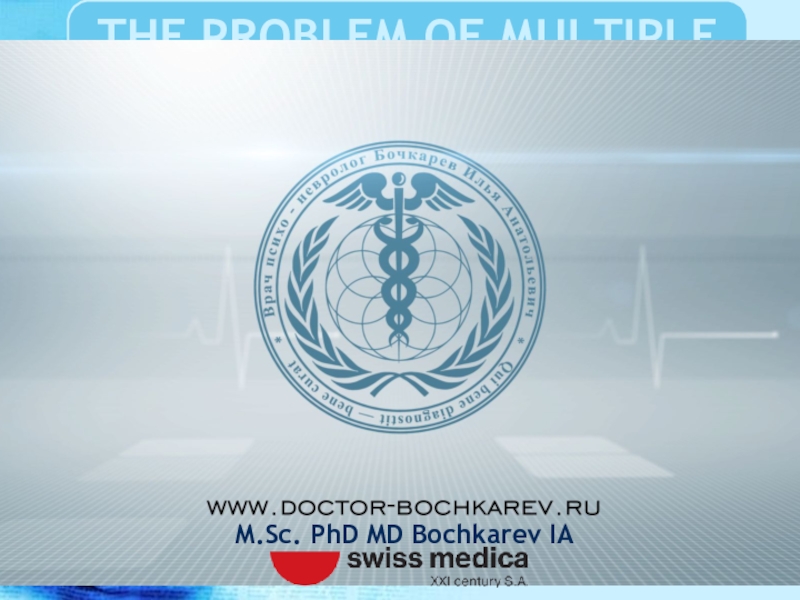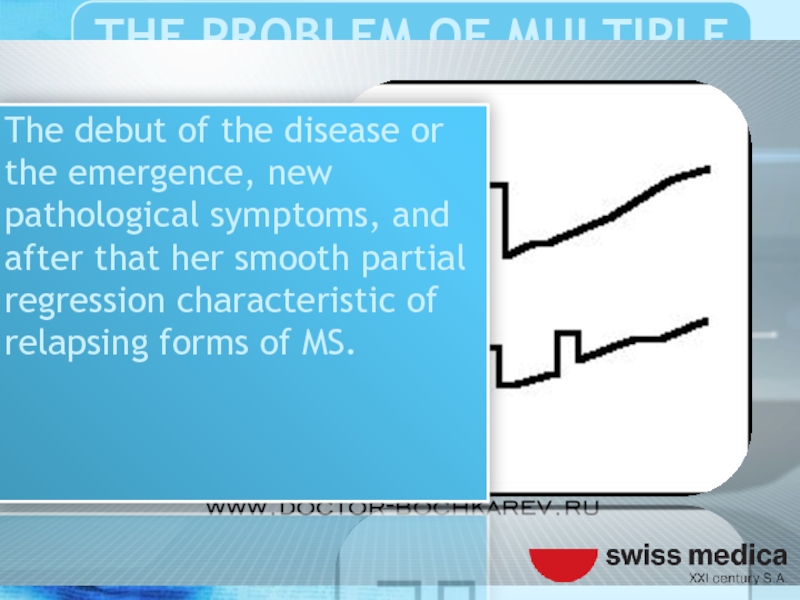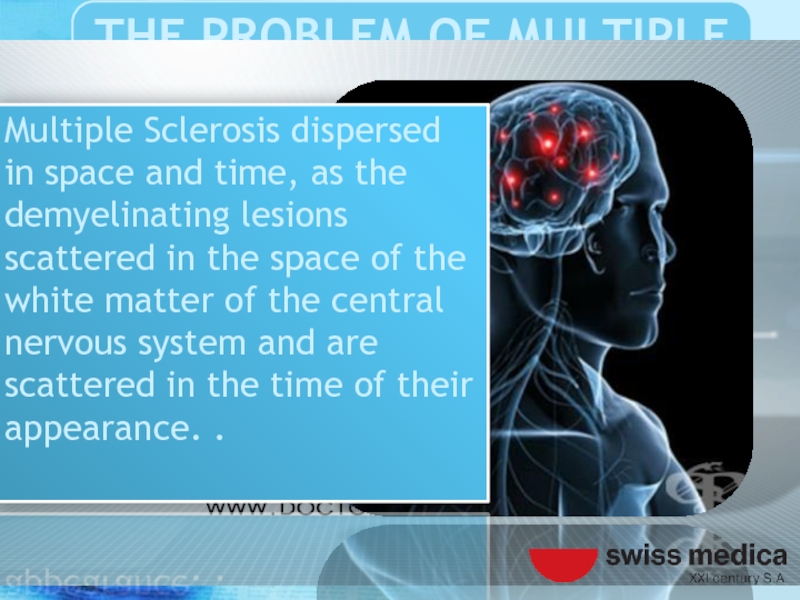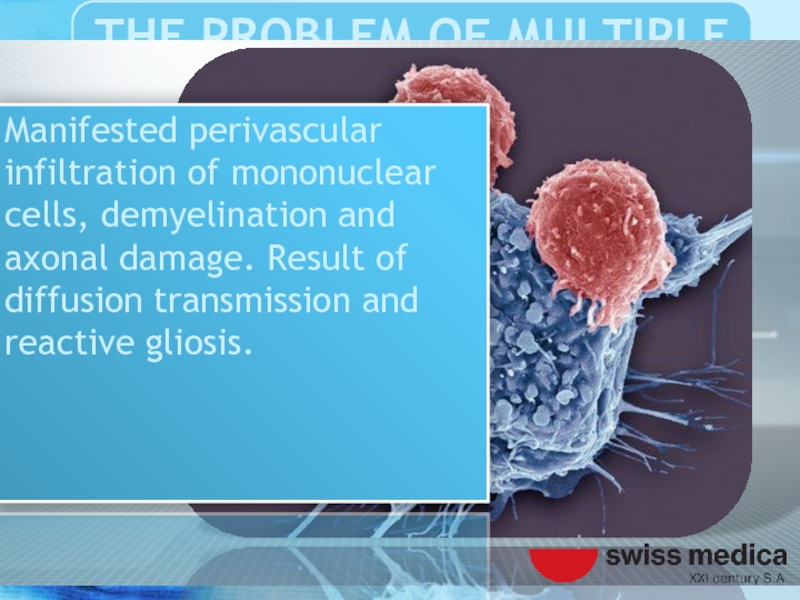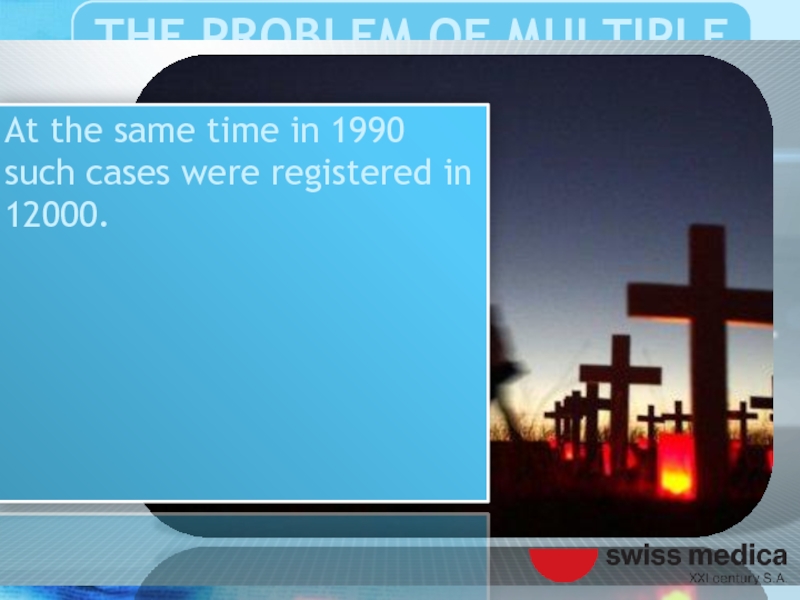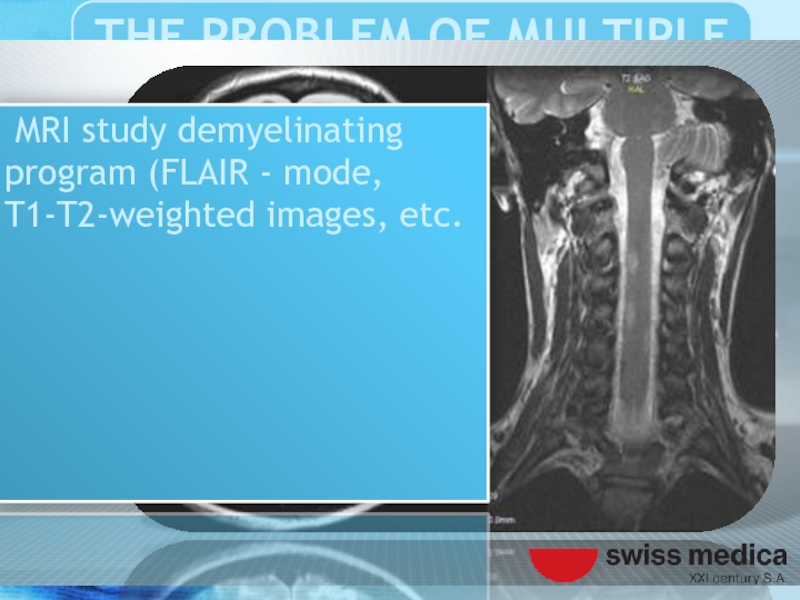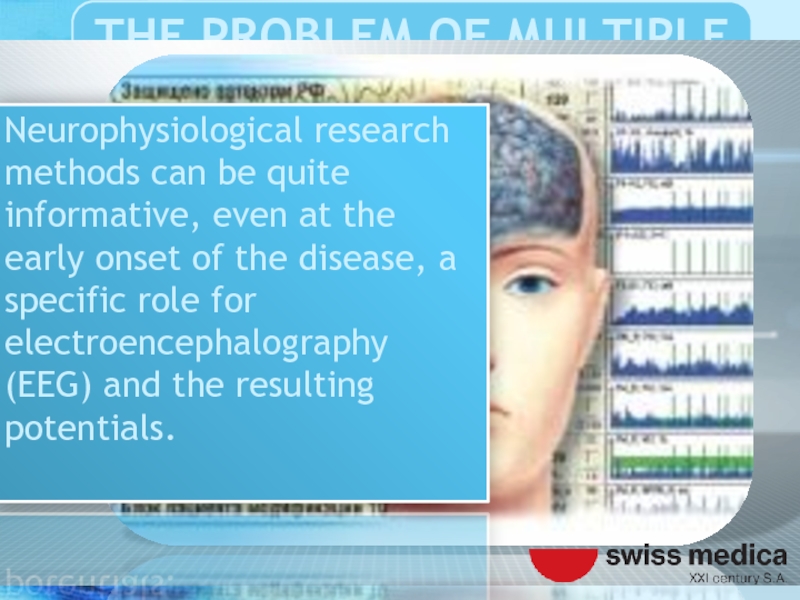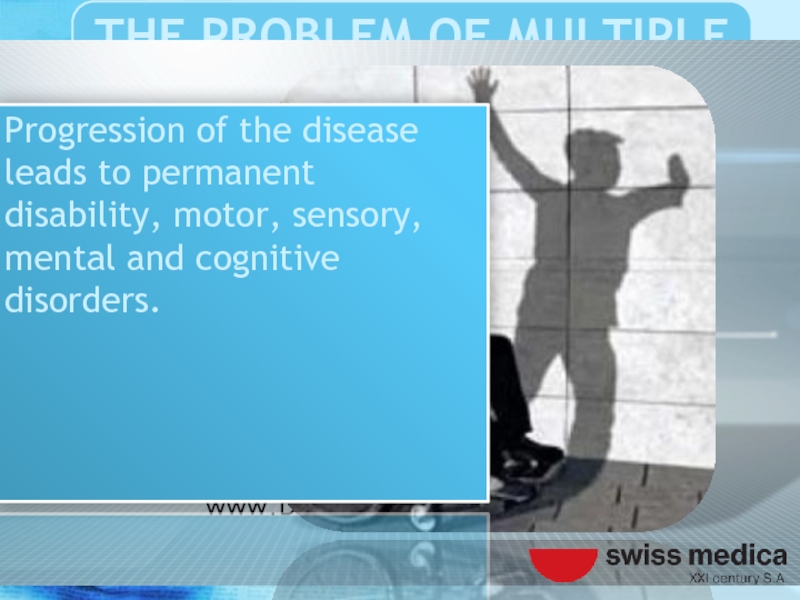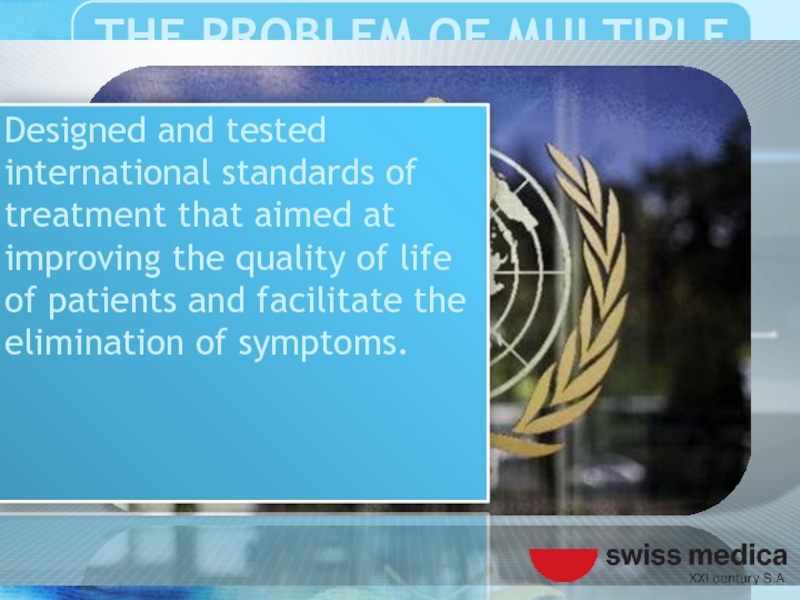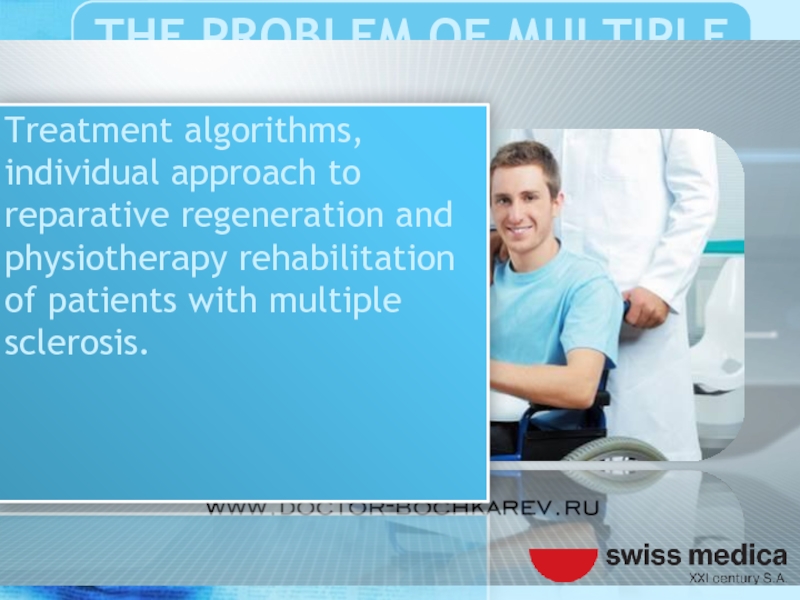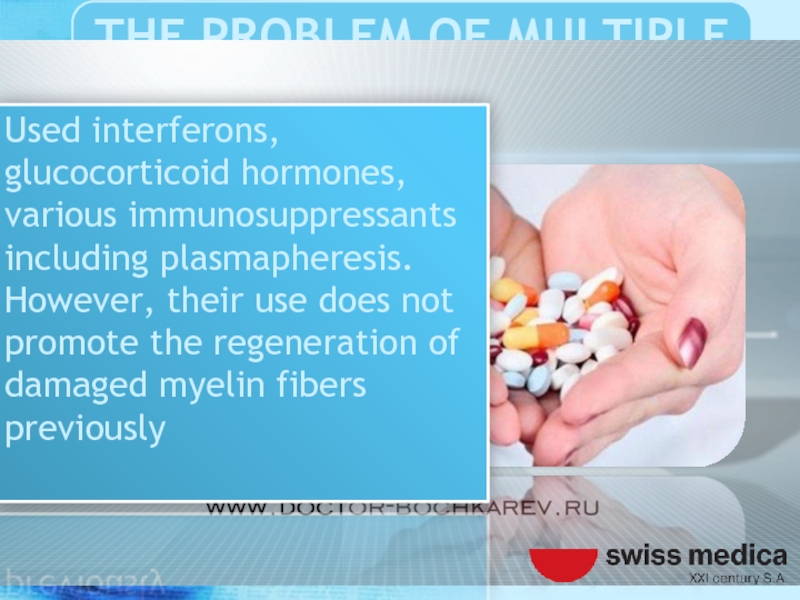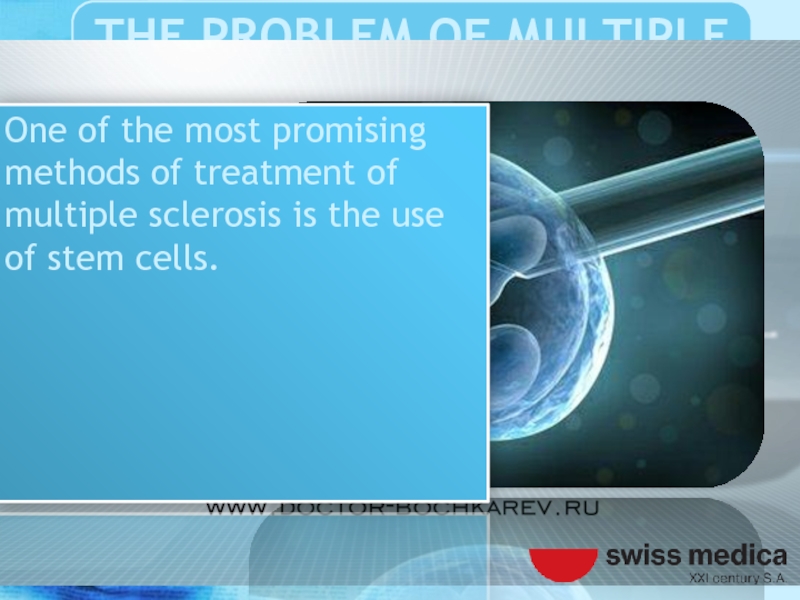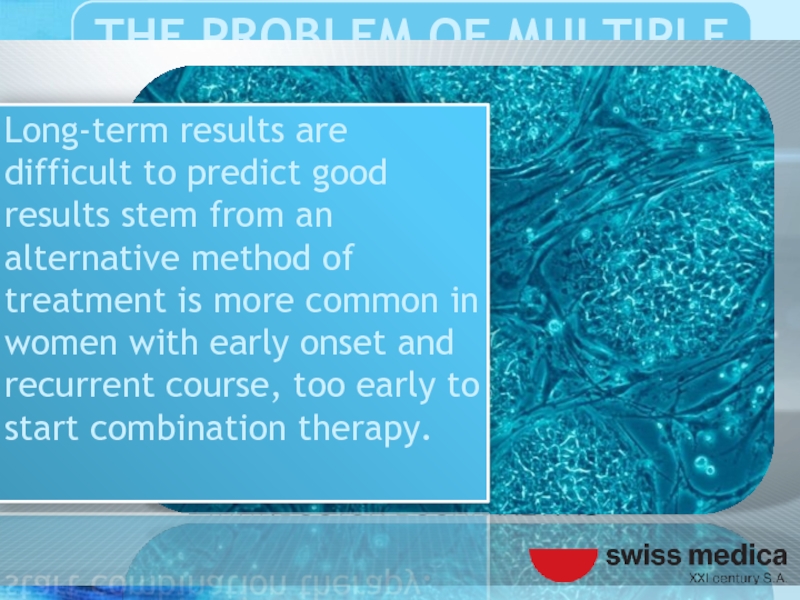- Главная
- Разное
- Дизайн
- Бизнес и предпринимательство
- Аналитика
- Образование
- Развлечения
- Красота и здоровье
- Финансы
- Государство
- Путешествия
- Спорт
- Недвижимость
- Армия
- Графика
- Культурология
- Еда и кулинария
- Лингвистика
- Английский язык
- Астрономия
- Алгебра
- Биология
- География
- Детские презентации
- Информатика
- История
- Литература
- Маркетинг
- Математика
- Медицина
- Менеджмент
- Музыка
- МХК
- Немецкий язык
- ОБЖ
- Обществознание
- Окружающий мир
- Педагогика
- Русский язык
- Технология
- Физика
- Философия
- Химия
- Шаблоны, картинки для презентаций
- Экология
- Экономика
- Юриспруденция
The problem of multiple sclerosis презентация
Содержание
- 1. The problem of multiple sclerosis
- 3. Multiple sclerosis (MS) also known as disseminated sclerosis (DS).
- 4. This nosology was first described in 1868 by French neurologist Jean-Martin Charcot.
- 5. MS is a demyelinating disease of the central nervous system.
- 6. That affects the myelin sheath oligodendrocytes, glial
- 8. Violation of axonal conduction results in loss
- 9. As a result, there are various neurological
- 10. Manifestations of MS can be very diverse
- 14. Disseminated sclerosis (DS) has several major clinical
- 15. The debut of the disease or the
- 16. Between attacks, symptoms may disappear completely. However,
- 17. The progression of old symptoms, the growth
- 18. Multiple Sclerosis dispersed in space and time,
- 19. The name "multiple sclerosis" is named because
- 20. Sclerotic plaques of different sizes that have
- 23. The etiology of MS and the pathological mechanism of demyelination is not completely clear.
- 24. Presumably based on genetic predisposition, dysfunction of
- 27. The pathogenic substrate is a chronic T
- 28. Manifested perivascular infiltration of mononuclear cells, demyelination
- 29. Lots gliosis and demyelination, distributed mainly in
- 32. The disease destroys the myelin protein preferably
- 34. Oligodendrocytes are specialized glial cells involved in
- 35. The myelin sheath is necessary to complete
- 37. The destruction of the myelin sheath leads
- 40. Important role in the failure of immunity given to heredity, environmental factors and infections.
- 41. These factors according to various studies have
- 42. Also, some researchers play a key role
- 44. The virus enters the body in early
- 46. Also noted the key patterns of
- 47. In particular, patients with multiple sclerosis showed
- 48. Vitamin D deficiency, smoking tobacco may be additional triggers the development of multiple sclerosis
- 50. Multiple sclerosis is the most common autoimmune disease affecting the central nervous system.
- 51. The statistics for 2008 show that MS
- 52. There was a statistically upward trend in
- 53. At the same time in 1990 such cases were registered in 12000.
- 54. The disease usually debuts at the age
- 55. Women suffer from MS almost twice as
- 57. For the diagnosis of multiple sclerosis requires
- 58. Field selection of clinical symptoms and combining
- 59. To confirm the clinical apperception apply additional
- 60. MRI study demyelinating program (FLAIR - mode, T1-T2-weighted images, etc.
- 62. Then, a lumbar puncture and cerebrospinal
- 63. For a more precise characterization demyelinating
- 65. Neurophysiological research methods can be quite informative,
- 66. Progression of the disease leads to permanent disability, motor, sensory, mental and cognitive disorders.
- 68. Treatment of multiple sclerosis are not currently found.
- 69. Until the end is not clear pathophysiological
- 70. However, modern medical science allows for effective palliative and symptomatic therapy.
- 71. Designed and tested international standards of treatment
- 72. Strategic effect of therapy aims at reducing
- 73. For these purposes at the current time
- 74. Treatment algorithms, individual approach to reparative regeneration
- 75. Tested and implemented new cutting-edge biotech treatments.
- 76. Of the currently available therapies advantageously used
- 77. Used interferons, glucocorticoid hormones, various immunosuppressants including
- 78. The therapy is aimed primarily improve lost
- 79. Despite that medicines used to treat MS
- 80. Poorly tolerated, and vice versa worsen the quality of life of patients.
- 81. So many people suffer from MS often
- 82. One of the most promising methods of
- 83. Studies on the use in the treatment
- 84. Long-term results are difficult to predict good
- 86. Treatment in Swiss Medica Clinic showed that stromal
- 87. This stem cell treatment leads to the
- 88. Until recently, it was believed that damaged
- 89. Swiss Medica Clinic has developed the Adult Autologous
- 90. During stem cell treatment a patient receives
- 91. Thus the reserve of the stem cells,
- 94. The goal of this MS Cumulative report
- 98. M.Sc. PhD MD Bochkarev IA
- 100. Ascherio A, Munger KL (April 2007). "Environmental
- 101. Lublin FD, Reingold SC (April 1996). "Defining
Слайд 6That affects the myelin sheath oligodendrocytes, glial cells covering the axons
of the neurons of the brain and spinal cord.
Слайд 8Violation of axonal conduction results in loss of the ability to
communicate the different structures of the central nervous system (CNS).
Слайд 9As a result, there are various neurological and psychiatric symptoms and
syndromes, the totality of which cause a variety of clinical picture of multiple sclerosis.
Слайд 10Manifestations of MS can be very diverse from the mental and
intellectual disorders to gross motor, and sensory dysfunction.
Слайд 14Disseminated sclerosis (DS) has several major clinical forms of the disease,
in which the dynamics of symptoms varies.
Слайд 15The debut of the disease or the emergence, new pathological symptoms,
and after that her smooth partial regression characteristic of relapsing forms of MS.
Слайд 16Between attacks, symptoms may disappear completely. However, permanent neurologic deficit is
very characteristic of the disease.
Слайд 17The progression of old symptoms, the growth and the emergence of
new, more typical of the progressive forms of MS.
Слайд 18Multiple Sclerosis dispersed in space and time, as the demyelinating lesions
scattered in the space of the white matter of the central nervous system and are scattered in the time of their appearance. .
Слайд 19The name "multiple sclerosis" is named because of the identified at
postmortem autopsy specific multiple non-specifically localized "scars“.
Слайд 20Sclerotic plaques of different sizes that have arisen as a consequence
of autoimmune damage to the white matter of the brain and spinal cord
Слайд 24Presumably based on genetic predisposition, dysfunction of the immune system autoimmune
aggression against myelin producing cells (oligodendrocytes).
Слайд 27The pathogenic substrate is a chronic T cell-induced autoimmune inflammation, in
which the body’s own immune system attacks the central nervous system.
Слайд 28Manifested perivascular infiltration of mononuclear cells, demyelination and axonal damage. Result
of diffusion transmission and reactive gliosis.
Слайд 29Lots gliosis and demyelination, distributed mainly in the white matter of
the central nervous system, radiant crown, cerebellum, brainstem and spinal cord.
Слайд 32The disease destroys the myelin protein preferably belongs to the structure
of the membrane of oligodendrocytes
Слайд 34Oligodendrocytes are specialized glial cells involved in the transmission of nerve
impulses and gain by which neurons communicate.
Слайд 35The myelin sheath is necessary to complete the transmission (saltatory conducting)
the bioelectric signals from the neuron through the axon affector to neuron effector.
Слайд 37The destruction of the myelin sheath leads to partial or complete
blockade of the nerve impulse which leads to clinical manifestations of multiple sclerosis.
Слайд 40Important role in the failure of immunity given to heredity, environmental
factors and infections.
Слайд 41These factors according to various studies have a leading role in
the development of autoimmune aggression to the myelin and oligodendrocytes.
Слайд 42Also, some researchers play a key role in the development of
autoimmune process, Ebstein-Barr virus.
Слайд 44The virus enters the body in early childhood and persists for
a long time manifests infectious mononucleosis or suspected autoimmune demyelination.
Слайд 46 Also noted the key patterns of response of the organism
to various environmental influences.
Слайд 47In particular, patients with multiple sclerosis showed a decrease tolerance to
the effects of solar radiation and ultraviolet radiation.
Слайд 48Vitamin D deficiency, smoking tobacco may be additional triggers the development
of multiple sclerosis
Слайд 50Multiple sclerosis is the most common autoimmune disease affecting the central
nervous system.
Слайд 51The statistics for 2008 show that MS suffer from 2 to
2.5 million people in the entire population of the world in its various climate zones, often in northern latitudes.
Слайд 52There was a statistically upward trend in the incidence of MS.
In 2013, 20,000 people died because of the DS.
Слайд 55Women suffer from MS almost twice as often as men. The
life expectancy of an average of 5 to 10 years lower than that of the healthy population.
Слайд 57For the diagnosis of multiple sclerosis requires a detailed medical history,
a thorough neurological examination with the use of special tests and procedures.
Слайд 58Field selection of clinical symptoms and combining them into syndromes exhibit
a preliminary diagnosis of the possible presence of demyelination.
Слайд 59To confirm the clinical apperception apply additional methods of diagnostics tools
such as brain imaging, magnetic resonance imaging
Слайд 62 Then, a lumbar puncture and cerebrospinal fluid obtained is investigated
for the presence of Monoclonal antibodies to myelin basic protein.
Слайд 63 For a more precise characterization demyelinating process of resorting to
additional consultations related professionals such as a psychiatrist, an immunologist.
Слайд 65Neurophysiological research methods can be quite informative, even at the early
onset of the disease, a specific role for electroencephalography (EEG) and the resulting potentials.
Слайд 66Progression of the disease leads to permanent disability, motor, sensory, mental
and cognitive disorders.
Слайд 69Until the end is not clear pathophysiological mechanism of occurrence of
the system demyelination. For this reason, it has not yet developed etiopathogenetic treatment.
Слайд 71Designed and tested international standards of treatment that aimed at improving
the quality of life of patients and facilitate the elimination of symptoms.
Слайд 72Strategic effect of therapy aims at reducing the recurrence of, reducing
the number of attacks, increased longevity of patients.
Слайд 73For these purposes at the current time successfully passed clinical trials
and actively introducing modern medicines.
Слайд 74Treatment algorithms, individual approach to reparative regeneration and physiotherapy rehabilitation of
patients with multiple sclerosis.
Слайд 75Tested and implemented new cutting-edge biotech treatments. Studies conducted in the
field of regenerative medicine using stem cells and other bioengineering technology
Слайд 76Of the currently available therapies advantageously used selective inhibition of autoimmune
attack against the nervous system.
Слайд 77Used interferons, glucocorticoid hormones, various immunosuppressants including plasmapheresis. However, their use
does not promote the regeneration of damaged myelin fibers previously
Слайд 78The therapy is aimed primarily improve lost function after CNS demyelinating
attack, and to prevent new attacks.
Слайд 79Despite that medicines used to treat MS are ineffective, and usually
have significant side effects which have a negative impact.
Слайд 81So many people suffer from MS often resort to alternative treatments,
despite the lack of credible evidence.
Слайд 82One of the most promising methods of treatment of multiple sclerosis
is the use of stem cells.
Слайд 83Studies on the use in the treatment of MS autologous stem
cells show a positive therapeutic effect.
Слайд 84Long-term results are difficult to predict good results stem from an
alternative method of treatment is more common in women with early onset and recurrent course, too early to start combination therapy.
Слайд 86Treatment in Swiss Medica Clinic showed that stromal stem cells administered intravenously
cross the blood brain barrier and copy neural stem cell activity.
[Park and Eve, 2009; Galli etc., 2008; Srivastava etc., 2008].
[Park and Eve, 2009; Galli etc., 2008; Srivastava etc., 2008].
Слайд 87This stem cell treatment leads to the replacement of damaged cells
and the restoration of the brain function. “In fact, a growing number of reports indicate that adult stem cells have the ability to stimulate the generation of new neurons, oligo-dendrocytes, and astrocytes” [Park and Eve, 2009; Galli etc., 2008; Srivastava etc., 2008].
Слайд 88Until recently, it was believed that damaged brain tissue is permanent
condition. Nowadays, the re-growth of brain cells and improvements of neurological function has been documented.
Слайд 89Swiss Medica Clinic has developed the Adult Autologous Stem Cell Therapy program
to treat a variety of conditions, including multiple sclerosis, cerebral palsy, muscular dystrophy, stroke, amyotrophic lateral sclerosis and traumatic brain injury, etc.
Слайд 90During stem cell treatment a patient receives 200 – 300 million
stem cells. This quantity of the restored plain cells not only covers daily losses, but exceeds them thousands of times.
Слайд 91Thus the reserve of the stem cells, almost lost for the
latest 15 – 20 years, is restored. Naturally, after such active cell replenishment any organ will become rejuvenated and renewed, because the new and active cells replace the old and damaged ones.
Слайд 94The goal of this MS Cumulative report is to assess the
success of Stem cells treatment in multiple sclerosis patients at Swiss Medica treatment center.
Слайд 100Ascherio A, Munger KL (April 2007). "Environmental risk factors for multiple
sclerosis. Part I: the role of infection". Annals of Neurology 61 (4): 288–99. doi:10.1002/ana.21117.PMID 17444504.
Berer K, Krishnamoorthy G (April 2014). "Microbial view of central nervous system autoimmunity". FEBS Letters. S0014-5793 (14): 00293–2. doi:10.1016/j.febslet.2014.04.007. PMID 24746689.
Clanet M (June 2008). "Jean-Martin Charcot. 1825 to 1893"(PDF). Int MS J 15 (2): 59–61. PMID 18782501.
Charcot, J. (1868). "Histologie de la sclerose en plaques". Gazette des hopitaux, Paris 41: 554–5.
Compston A, Coles A (April 2002). "Multiple sclerosis".Lancet 359 (9313): 1221–31. doi:10.1016/S0140-6736(02)08220-X.PMID 11955556
Compston A, Coles A (October 2008). "Multiple sclerosis". Lancet 372 (9648): 1502–17. doi:10.1016/S0140-6736(08)61620-7. PMID 18970977
Cross A.H., Naismith R.T. et al. Established and novel disease-modifying treatments in multiple sclerosis. J Intern Med. 2014 Apr; 275(4):350-63. doi: 10.1111/joim.12203. Epub 2014 Mar 11.
GBD 2013 Mortality and Causes of Death, Collaborators (17 December 2014). "Global, regional, and national age-sex specific all-cause and cause-specific mortality for 240 causes of death, 1990-2013: a systematic analysis for the Global Burden of Disease Study 2013."Lancet 385: 117–171 (table 2). doi:10.1016/S0140-6736(14)61682-2.PMC 4340604. PMID 25530442.
Berer K, Krishnamoorthy G (April 2014). "Microbial view of central nervous system autoimmunity". FEBS Letters. S0014-5793 (14): 00293–2. doi:10.1016/j.febslet.2014.04.007. PMID 24746689.
Clanet M (June 2008). "Jean-Martin Charcot. 1825 to 1893"(PDF). Int MS J 15 (2): 59–61. PMID 18782501.
Charcot, J. (1868). "Histologie de la sclerose en plaques". Gazette des hopitaux, Paris 41: 554–5.
Compston A, Coles A (April 2002). "Multiple sclerosis".Lancet 359 (9313): 1221–31. doi:10.1016/S0140-6736(02)08220-X.PMID 11955556
Compston A, Coles A (October 2008). "Multiple sclerosis". Lancet 372 (9648): 1502–17. doi:10.1016/S0140-6736(08)61620-7. PMID 18970977
Cross A.H., Naismith R.T. et al. Established and novel disease-modifying treatments in multiple sclerosis. J Intern Med. 2014 Apr; 275(4):350-63. doi: 10.1111/joim.12203. Epub 2014 Mar 11.
GBD 2013 Mortality and Causes of Death, Collaborators (17 December 2014). "Global, regional, and national age-sex specific all-cause and cause-specific mortality for 240 causes of death, 1990-2013: a systematic analysis for the Global Burden of Disease Study 2013."Lancet 385: 117–171 (table 2). doi:10.1016/S0140-6736(14)61682-2.PMC 4340604. PMID 25530442.
Слайд 101Lublin FD, Reingold SC (April 1996). "Defining the clinical course of
multiple sclerosis: results of an international survey". Neurology 46 (4): 907–11.doi:10.1212/WNL.46.4.907. PMID 8780061
Milo R, Kahana E (March 2010). "Multiple sclerosis: geoepidemiology, genetics and the environment". Autoimmun Rev 9 (5): A387-94. Doi:10.1016/j.autrev.2009.11.010.PMID 19932200
Murray ED, Buttner EA, Price BH (2012). "Depression and Psychosis in Neurological Practice". In Daroff R, Fenichel G, Jankovic J, Mazziotta J. Bradley's neurology in clinical practice. (6th ed.). Philadelphia, PA: Elsevier/Saunders. ISBN 1-4377-0434-4
Nakahara J, Maeda M, Aiso S, Suzuki N (February 2012). "Current concepts in multiple sclerosis: autoimmunity versus oligodendrogliopathy.". Clinical reviews in allergy & immunology 42 (1): 26–34. doi:10.1007/s12016-011-8287-6. PMID 22189514
Pittock SJ, Lucchinetti CF: The pathology of MS: new insights and potential clinical applications. Neurologist 2007, 13:45-56.
Uccelli A., Laroni A., Freedman M.S. (2011) Mesenchymal stem cells for the treatment of multiple sclerosis and other neurological diseases. Lancet Neurol 10: 649–656.
Weinshenker BG (1994). "Natural history of multiple sclerosis".Annals of Neurology 36 (Suppl): S6–11. doi:10.1002/ana.410360704.PMID 8017890.
World Health Organization (2008). Atlas: Multiple Sclerosis Resources in the World 2008 (PDF). Geneva: World Health Organization. pp. 15–16. ISBN 92-4-156375-3.
Milo R, Kahana E (March 2010). "Multiple sclerosis: geoepidemiology, genetics and the environment". Autoimmun Rev 9 (5): A387-94. Doi:10.1016/j.autrev.2009.11.010.PMID 19932200
Murray ED, Buttner EA, Price BH (2012). "Depression and Psychosis in Neurological Practice". In Daroff R, Fenichel G, Jankovic J, Mazziotta J. Bradley's neurology in clinical practice. (6th ed.). Philadelphia, PA: Elsevier/Saunders. ISBN 1-4377-0434-4
Nakahara J, Maeda M, Aiso S, Suzuki N (February 2012). "Current concepts in multiple sclerosis: autoimmunity versus oligodendrogliopathy.". Clinical reviews in allergy & immunology 42 (1): 26–34. doi:10.1007/s12016-011-8287-6. PMID 22189514
Pittock SJ, Lucchinetti CF: The pathology of MS: new insights and potential clinical applications. Neurologist 2007, 13:45-56.
Uccelli A., Laroni A., Freedman M.S. (2011) Mesenchymal stem cells for the treatment of multiple sclerosis and other neurological diseases. Lancet Neurol 10: 649–656.
Weinshenker BG (1994). "Natural history of multiple sclerosis".Annals of Neurology 36 (Suppl): S6–11. doi:10.1002/ana.410360704.PMID 8017890.
World Health Organization (2008). Atlas: Multiple Sclerosis Resources in the World 2008 (PDF). Geneva: World Health Organization. pp. 15–16. ISBN 92-4-156375-3.
